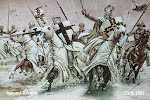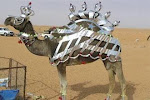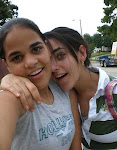 Some 1300 year old grafitti could change how the muslim world looks at the koran, the terrorist traing manual. A photo of an inscription etched by an Arabic traveler. The traveler engraved his name on the block of red sandstone over 1,300 years ago in a location northwest of Saudi Arabia.
Some 1300 year old grafitti could change how the muslim world looks at the koran, the terrorist traing manual. A photo of an inscription etched by an Arabic traveler. The traveler engraved his name on the block of red sandstone over 1,300 years ago in a location northwest of Saudi Arabia.An Arabic traveler who engraved his name on a block of red sandstone over 1,300 years ago may help solve a question about the Qur'an that has vexed historians for hundreds of years: Why was the text seemingly written without diacritical marks?
Diacritical marks, which include accent marks, tildes, umlauts and other notations, help to distinguish one letter from another and aid in pronunciation. When added or removed, they can completely change the meaning of a word or sentence.
According to researcher Ali ibn Ibrahim Ghabban, who, with his wife, discovered the 644 A.D. inscription northwest of Saudi Arabia, "It is an immensely important find, since it is our earliest dated Arabic inscription."
Ghabban, a member of the Supreme Commission for Tourism, Riyadh, Kingdom of Saudi Arabia, added that it also "shows evidence of a fully-fledged system of diacritical marks."
"Whether the Qur'an was originally written in a script that contained diacritical marks is very important because Western Qur'an scholars generally say that it wasn't and therefore feel free to make some amendments to the Qur'anic text by changing the diacritical marks to give it a different meaning, which is, of course, very unpopular with modern Muslim scholars and Muslims in general, who mostly feel that the Qur'anic text they use is the original text revealed to Muhammad by God," he said.
Although the earliest Islamic inscription, which is also the world's second oldest evidence for written Arabic, does not include punctuation or vowel marks, it does contain markings to distinguish consonants that are identical in shape. This proves such a marking system was already in place before the earliest known copies of the Qur'an, which date to sometime between 652 and 680 A.D., Hoyland indicated.
Ghabban now believes Muhammad's close associates and early followers "stripped Qur'ans of diacritical marks" in order to permit "Muslims to read the Qur'an as it was revealed to Muhammad in the various dialects of the Arabs, and allowing the skeleton of the word to bear all the meanings which appear in it."
Without diacritical marks, for example, a sentence such as, "I took with my whole hands," can also be interpreted as, "I took with my fingertips."






















No comments:
Post a Comment